The AMD A8-7650K APU Review, Also New Testing Methodology
by Ian Cutress on May 12, 2015 10:00 AM ESTOffice Performance
The dynamics of CPU Turbo modes, both Intel and AMD, can cause concern during environments with a variable threaded workload. There is also an added issue of the motherboard remaining consistent, depending on how the motherboard manufacturer wants to add in their own boosting technologies over the ones that Intel would prefer they used. In order to remain consistent, we implement an OS-level unique high performance mode on all the CPUs we test which should override any motherboard manufacturer performance mode.
All of our benchmark results can also be found in our benchmark engine, Bench.
Dolphin Benchmark: link
Many emulators are often bound by single thread CPU performance, and general reports tended to suggest that Haswell provided a significant boost to emulator performance. This benchmark runs a Wii program that raytraces a complex 3D scene inside the Dolphin Wii emulator. Performance on this benchmark is a good proxy of the speed of Dolphin CPU emulation, which is an intensive single core task using most aspects of a CPU. Results are given in minutes, where the Wii itself scores 17.53 minutes.
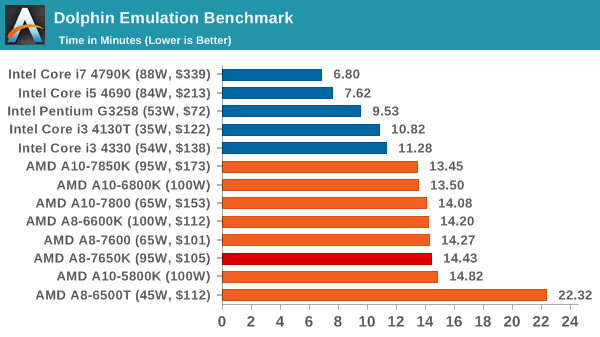
Dolphin likes high IPC and clock frequency, which indicates that the highest clocked APUs perform the best out of AMD here. Because the benchmark is single threaded, even a dual core Intel wins though.
WinRAR 5.0.1: link
Our WinRAR test from 2013 is updated to the latest version of WinRAR at the start of 2014. We compress a set of 2867 files across 320 folders totaling 1.52 GB in size – 95% of these files are small typical website files, and the rest (90% of the size) are small 30 second 720p videos.

The varied-thread workload of WinRAR seems to vary between the dual core Intels and the dual module AMD chips, showing that threads matter.
3D Particle Movement
3DPM is a self-penned benchmark, taking basic 3D movement algorithms used in Brownian Motion simulations and testing them for speed. High floating point performance, MHz and IPC wins in the single thread version, whereas the multithread version has to handle the threads and loves more cores.

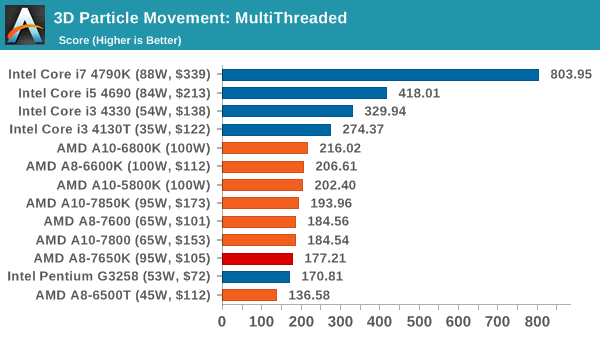
In this nieve benchmark, the compiler prefers x87 style commands which AMD's Bulldozer based architectures isn't too fond of. This benchmark is meant to be a representation of crude scientific code, similar to that used in a research lab. Ultimately, Bulldozer architectures such as Kaveri prefer specific commands, especially when dealing with basic math.
FastStone Image Viewer 4.9
FastStone is the program I use to perform quick or bulk actions on images, such as resizing, adjusting for color and cropping. In our test we take a series of 170 images in various sizes and formats and convert them all into 640x480 .gif files, maintaining the aspect ratio. FastStone does not use multithreading for this test, and results are given in seconds.
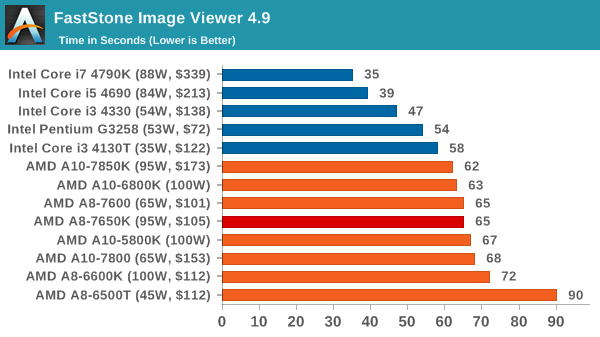
Web Benchmarks
On the lower end processors, general usability is a big factor of experience, especially as we move into the HTML5 era of web browsing. For our web benchmarks, we take four well known tests with Chrome 35 as a consistent browser.
Sunspider 1.0.2

Mozilla Kraken 1.1

WebXPRT
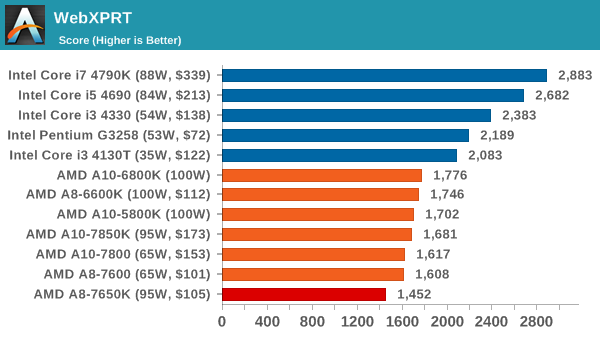
Google Octane v2
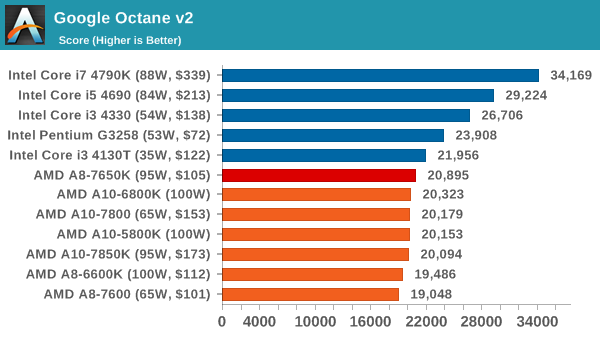










177 Comments
View All Comments
r3loaded - Tuesday, May 12, 2015 - link
Now, more than ever, AMD needs Zen. They still have nothing out on the market that can conclusively beat my four year old 2500K.close - Tuesday, May 12, 2015 - link
Even Intel barely has something that can conclusively beat your four year old 2500K :). Progress isn't what it used to be.Frenetic Pony - Tuesday, May 12, 2015 - link
That's because Intel's efforts are solely focused on laptops/mobile. They dominate the high end, and would only compete with themselves. This at least leaves AMD an opening next year though, as cramming battery life into the Core series has stalled Intel's development of performance per mm^2 other than process shrink.mapesdhs - Tuesday, May 12, 2015 - link
Especially once oc'd of course. What clock are you using?I'm building a 2500K system for a friend atm, easily the best value on a very limited budget.
r3loaded - Tuesday, May 12, 2015 - link
4.5Ghz for full time use on air in my own system. But yeah, even at stock speeds it's still not a contest for the Intel chip.der - Tuesday, May 12, 2015 - link
Awesome testing Methology guys, and definitely a great review.azazel1024 - Tuesday, May 12, 2015 - link
Ian, I'll grant you it isn't abysmal performance and I doubt most casual users would notice a difference. It doesn't seem honest to say that, "While the APUs aren't necessarily ahead in terms of absolute performance, and in some situations they are behind, but with the right combination of hardware the APU route can offer equivalent performance at a cheaper rate"Uhhhh, unless I misread the benchmarks, the AMD processors are at least a little behind to a lot behind vaguely similarly priced Intel processors in the vast majority of CPU benchmarks. That doesn't say "in some" to me, that to me says in most are almost all.
The only place I see them is either extreme budget or your size constrictions prevent you from getting even a cheap discrete graphics card. Cost and performance wise, you'd probably be better off with something like a GTX750 or 750ti combined with an Intel Celeron or Pentium Haswell processor.
I really want Zen to be a turn around.
A quick Amazon check shows that an Intel Haswell Pentium, plus H97 board, plus 2x2GB of DDR3-1600 and a GTX750 would run you in the region of $250. Granted that doesn't include case ($30 for low end), PSU ($40 for a good low power one) or storage ($90 for a 120GB SSD or $50-60 for a 2TB HDD), but it sounds like it was well within that $300 budget considering the bits that could have/were reused...
Deffinitely to each his own, I just think especially once you start getting in to "dual graphics" (even low end), you are almost certainly better if you are talking two discrete cards, or just getting a slightly faster discrete card than relying on the iGPU+dGPU to drive things as well as a somewhat better processor, that might not be any more expensive (or cheaper, Haswell Pentium/Celeron).
galta - Tuesday, May 12, 2015 - link
No matter what people say, AMD is driving itself into an ever tighter corner, be it on the CPU or GPU realms.One really has a hard time trying to justify choosing them over Intel/nVidia, but for some very specific – and sometimes bizarre - circumstances (eg.: because the only thing I do is compact files on WinRar, I end up finding AMD FX and its 8 cores the best cost/benefit ratio!)
A8-7650K is no different.
It is said that things are like that. As a consumer with no intrinsic brand preferences, I would like to see real competition.
anubis44 - Tuesday, May 12, 2015 - link
Try compressing those files using 7Zip, and you'll see a dramatic improvement on the FX-8350. 7Zip is highly optimized for multi-threading, whereas WinRAR is single-threaded.galta - Tuesday, May 12, 2015 - link
No, it's not: http://forums.anandtech.com/showthread.php?t=22533...Even if it were, that's not the point.
How many of us, inclunding the bizarre ones, do only compacting on their PCs?